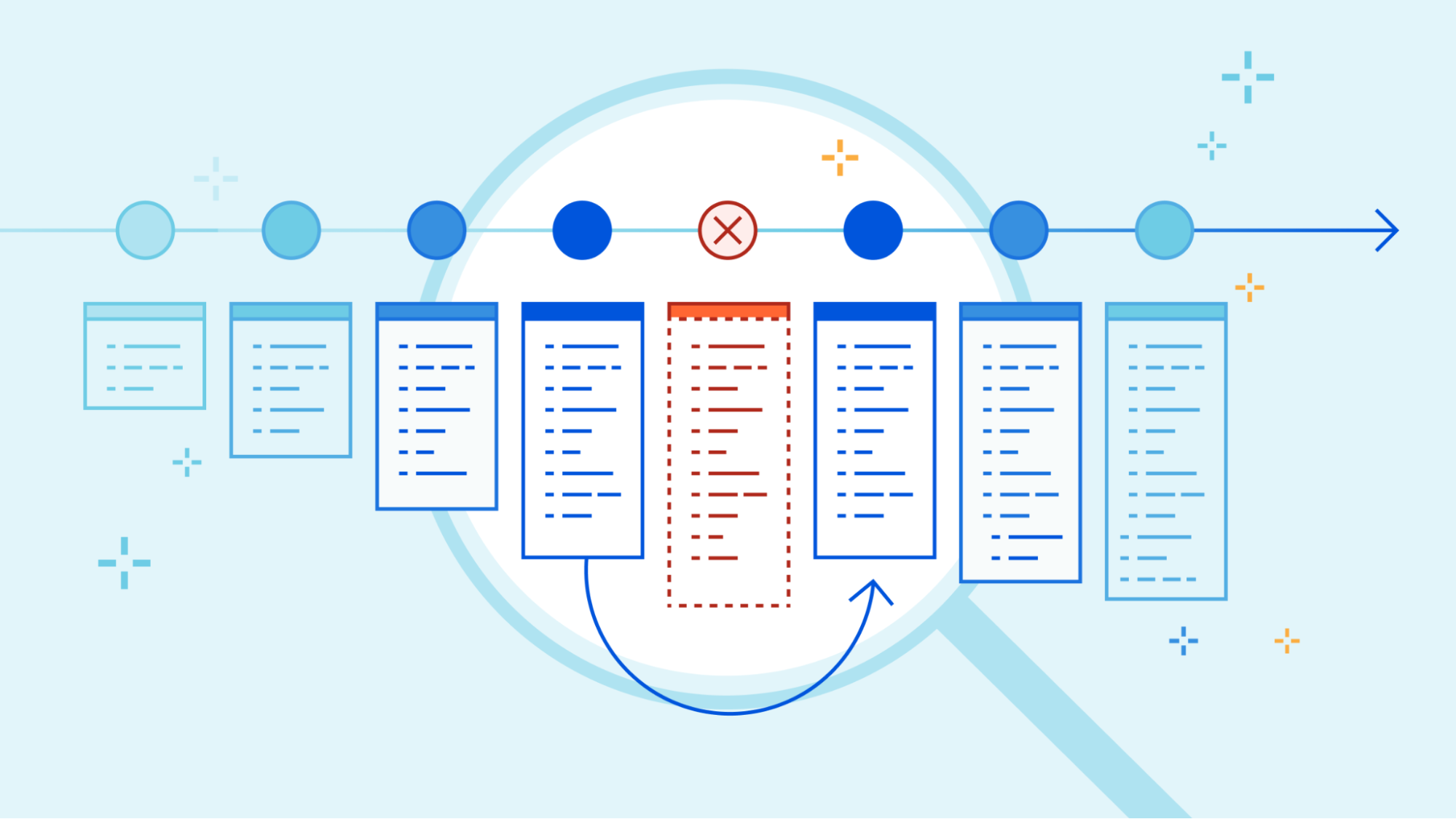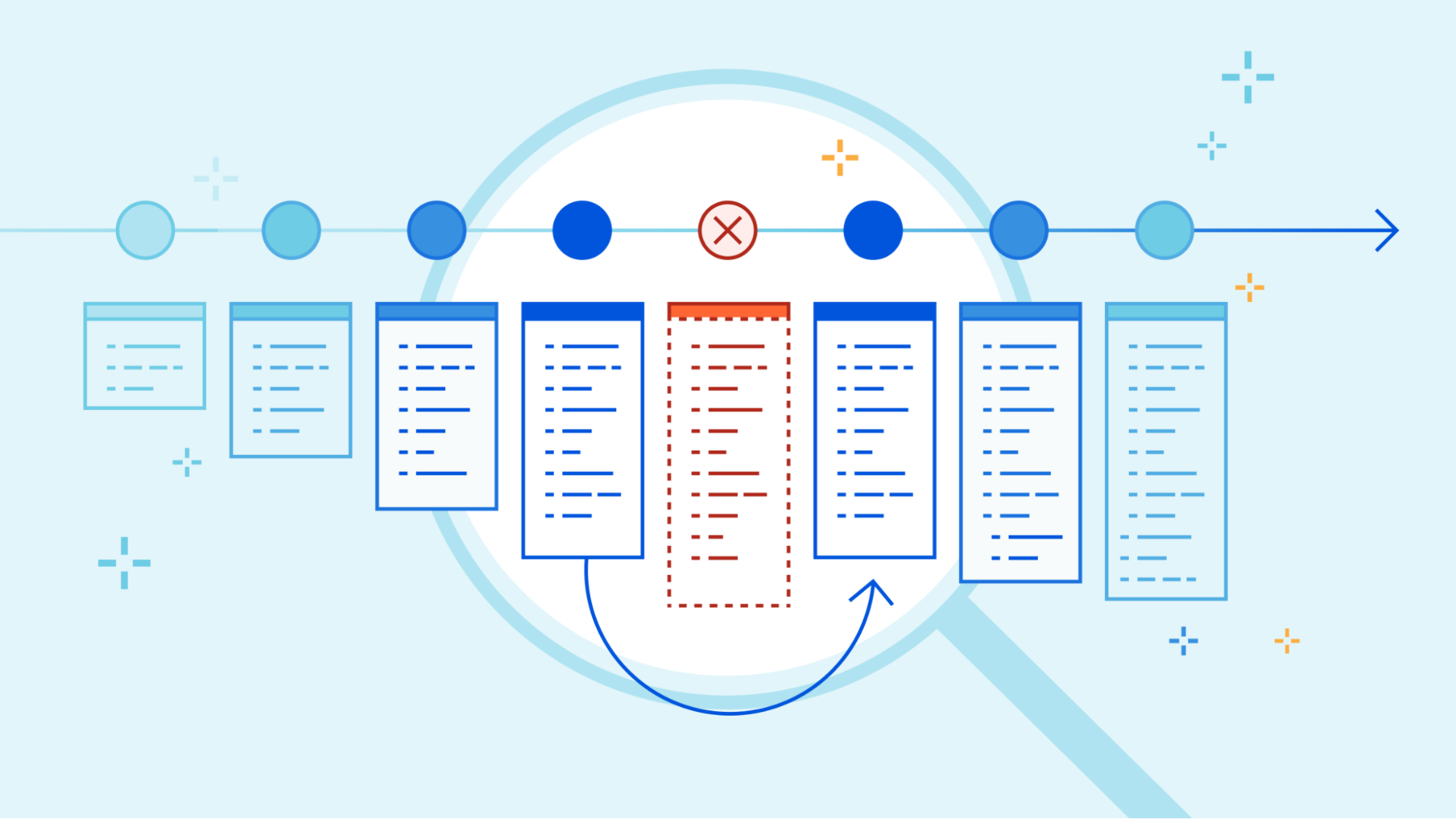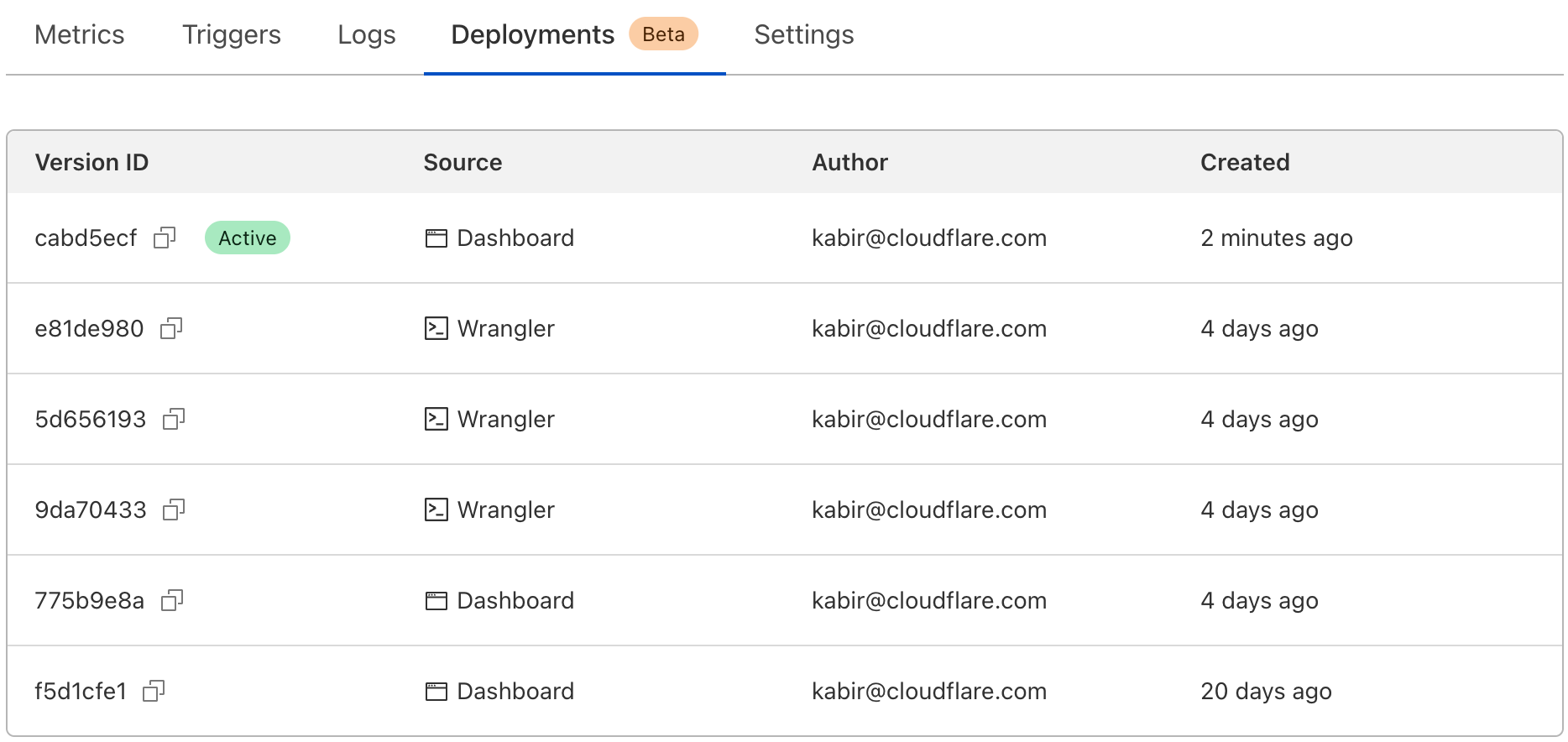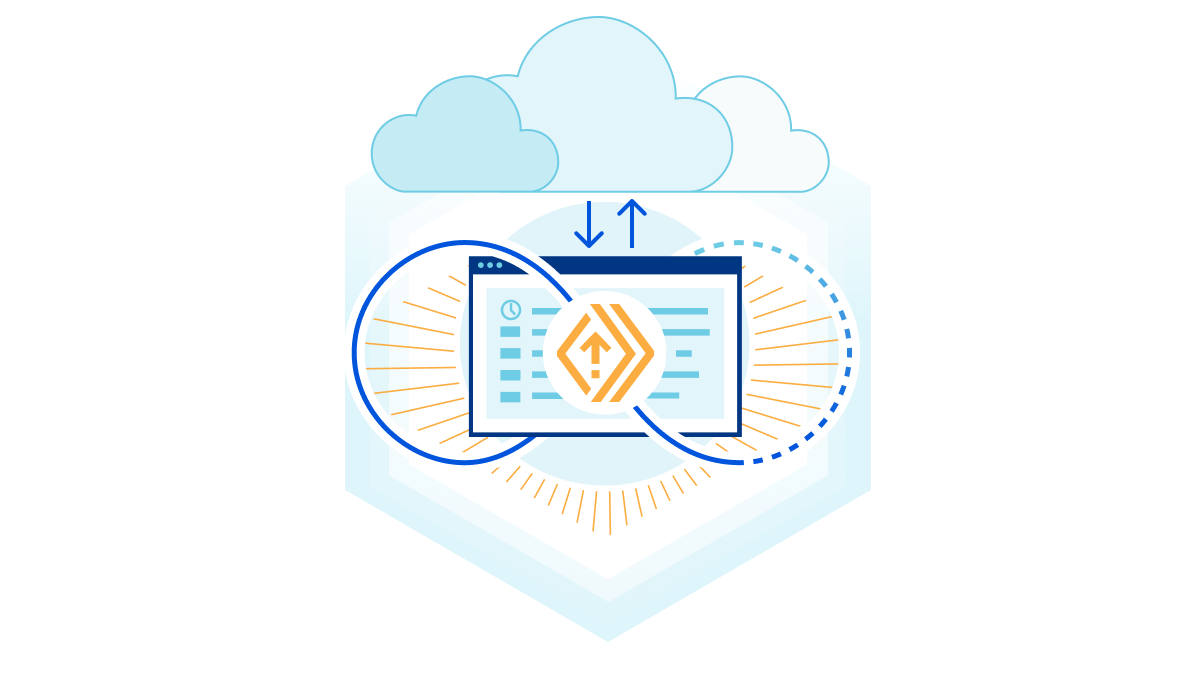Author Archives: Kabir Sikand
Author Archives: Kabir Sikand


Today we’re happy to introduce Deployments for Workers. Deployments allow developers to keep track of changes to their Worker; not just the code, but the configuration and bindings as well. With deployments, developers now have access to a powerful audit log of changes to their production applications.
And tracking changes is just the beginning! Deployments provide a strong foundation to add: automated deployments, rollbacks, and integration with version control.
Today we’ll dive into the details of deployments, how you can use them, and what we’re thinking about next.
Deployments are a powerful new way to track changes to your Workers. With them, you can track who’s making changes to your Workers, where those changes are coming from, and when those changes are being made.

Cloudflare reports on deployments made from wrangler, API, dashboard, or Terraform anytime you make changes to your Worker’s code, edit resource bindings and environment variables, or modify configuration like name or usage model.

We expose the source of your deployments, so you can track where changes are coming from. For example, if you have a CI job that’s responsible for changes, and you see a user made a change through the Cloudflare dashboard, it’s easy Continue reading


A few months ago we launched Custom Domains into an open beta. Custom Domains allow you to hook up your Workers to the Internet, without having to deal with DNS records or certificates – just enter a valid hostname and Cloudflare will do the rest! The beta’s over, and Custom Domains are now GA.
Custom Domains aren’t just about a seamless developer experience; they also allow you to build a globally distributed instantly scalable application on Cloudflare’s Developer Platform. That’s because Workers leveraging Custom Domains have no concept of an ‘Origin Server’. There’s no ‘home’ to phone to - and that also means your application can use the power of Cloudflare’s global network to run your application, well, everywhere. It’s truly serverless.
Today we’ll start a series of posts outlining a simple todo list application. We’ll start with an API and hook it up to the Internet using Custom Domains.
With Custom Domains, you’re treating the whole network as the application server. Any time a request comes into a Cloudflare data center, Workers are triggered in that data center and connect to resources across the network as needed. Our developers don’t need to Continue reading


Today, we’re happy to announce Custom Domains for Workers. Custom Domains allow you to hook up a domain to your Worker, without having to fuss about certificates, origin servers or DNS – it just works. Let’s take a look at how we built Custom Domains and how you can use them.
Under the hood, we’re leveraging Cloudflare DNS to register your Worker as the origin for your domain. All you need to do is head to your Worker, go to the Triggers tab, and click Add Custom Domain. Cloudflare will handle creating the DNS record and issuing a certificate on your behalf. In seconds, your domain will point to your Worker, and all you need to worry about is writing your code. We’ll also help guide you through the process of creating these new records and replace any existing ones. We built this with a straightforward ethos in mind: we should be clear and transparent about actions we’re taking, and make it easy to understand.
We’ve made a few welcome changes when you’re using a Custom Domain on your Worker. First off, when you send a request to any path on that Custom Domain, your Continue reading


Today, we’re happy to unveil a new way to communicate between your Workers. In the spirit of baking more and more flexibility into our Developer Platform, our team has been hard at work building a new API to facilitate Worker to Worker communication: Service Bindings. Service Bindings allow your Workers to send requests to other Workers Services, from your code, without those requests going over the Internet. It opens up a world of composability that was previously closed off by a difficult interface, and makes it a lot easier for you to build complex applications on our developer platform.
Service Bindings allow teams to segment application logic across multiple Workers. By segmenting your logic, your teams can now build with more confidence by only deploying narrowly scoped changes to your applications, instead of recommitting the whole application every time. Service Bindings give developers both composability and confidence. We’ve seen some excellent uses so far, and today we’ll go through one of the more common examples. Alongside this functionality, we'll show you how Cloudflare’s cost efficiency will save you money.
Service Bindings allow you to easily expand the number of services running on a single request. Developers Continue reading


At Cloudflare, we are on a mission to help build a better Internet. We continue to grow our network, and it is important for us to do so responsibly.
Since Earth Day 2021, some pieces of this effort have included:
And we are just getting started. We are working to make the Cloudflare network — and our customers’ websites, applications, and networks — as efficient as possible in terms of design, hardware, systems, and protocols. After all, we do not want to lose sight of our responsibilities to our home: our planet Earth.
During Impact Week last year, we began testing Green Compute in a closed beta. Green Compute makes Workers Cron Triggers run only in facilities that are powered by renewable energy. We are hoping to incentivize more facilities to implement responsible climate and energy policies.
With Green Compute enabled, Workers Cron Triggers will run Continue reading


Our mission is to enable developers to build their applications, end to end, on our platform, and ruthlessly eliminate limitations that may get in the way. Today, we're excited to announce you can build large, data-intensive applications on our network, all without breaking the bank; starting today, we're dropping egress fees to zero.
Building more on any platform historically comes with a caveat — high data transfer cost. These costs often come in the form of egress fees. Especially in the case of data intensive workloads, egress data transfer costs can come at a high premium, depending on the provider.
What exactly are data egress fees? They are the costs of retrieving data from a cloud provider. Cloud infrastructure providers generally pay for bandwidth based on capacity, but often bill customers based on the amount of data transferred. Curious to learn more about what this means for end users? We recently wrote an analysis of AWS’ Egregious Egress — a good read if you would like to learn more about the ‘Hotel California’ model AWS has spun up. Effectively, data egress fees lock you into their platform, making you choose your provider based not on Continue reading


At Cloudflare, we’re building the best compute platform in the world. We want to make it easy, seamless, and obvious to build your applications with us. But simply making the best compute platform is not enough — at the heart of your applications are the data they interact with.
Cloudflare has multiple data storage solutions available today: Workers KV, R2, and Durable Objects. All three follow Cloudflare’s design goals for Workers: global by default, infinitely scalable, and delightful for developers to use. We’ve partnered with third-party storage solutions like Fauna, MongoDB and Prisma, who have built data platforms that align beautifully with our design goals and written tutorials for databases that already support HTTP connections.
The one area that’s been sorely missed: relational databases. Cloudflare itself runs on relational databases, and we’re not alone. In April, we asked which Node libraries you wanted us to support, and four of the top five requests were related to databases. For this Full Stack Week, we asked ourselves: how could we support relational databases in a way that aligned with our design goals?
Today, we’re taking a first step towards that world by announcing support for relational databases, including Postgres and Continue reading


Cloudflare’s Workers platform is a powerful tool; a single compute platform for tasks as simple as manipulating requests or complex as bringing application logic to the network edge. Today I want to show you how to do server-side rendering at the network edge using Workers Sites, Wrangler, HTMLRewriter, and tools from the broader Workers platform.
Each page returned to the user will be static HTML, with dynamic content being rendered on our serverless stack upon user request. Cloudflare’s ability to run this across the global network allows pages to be rendered in a distributed fashion, close to the user, with miniscule cold start times for the application logic. Because this is all built into Cloudflare’s edge, we can implement caching logic to significantly reduce load times, support link previews, and maximize SEO rankings, all while allowing the site to feel like a dynamic application.
In the early days of the web pages were almost entirely static - think raw HTML. As Internet connections, browsers, and hardware matured, so did the content on the web. The world went from static sites to more dynamic content, powered by technologies like CGI, PHP, Flash, CSS, JavaScript, and Continue reading